Featured customer case
Lumada customer case code: UC-01942S
Chemicals Informatics—Using AI to reduce the time and cost of developing new products
2023-01-31

Manufacturers are constantly striving to improve and develop new materials in order to resolve a broad range of issues ranging from upgrading product performance to making products more environmentally friendly. This article looks at some of the customer cases for discovering unknown compounds possessing highly sought-after properties. To speed up the discovery of such compounds, Hitachi has compiled a database that contains vast amounts of information on compounds. Customers can use this to conduct exhaustive searches for information on a scale for which manual searches are impossible.
The comprehensive yet rapid selection of compounds based on vast amounts of data helps give our customers an edge over the competition in the development of materials that return to nature, and in capturing market share through the manufacture and sale of products using such materials. These products not only stand to bolster our customer’s reputation for environmental awareness, the recognition of their market value leads to increased sales.
Co-create with Lumada! Use our proprietary AI to analyze publicly available data
Currently, research and development (R&D) of materials can take some 10 years from the time a new compound is discovered until the time it is eventually commercialized as a product available on the market.
Aiming to enhance product performance, many manufacturers pursue long-term materials development. They also face a new challenge. Since the adoption of SDGs in 2015, there have been calls to develop a stronger awareness of the need to prioritize environmental considerations in order to achieve carbon neutrality (a state in which greenhouse emissions are essentially zero).
To develop products that can satisfy practical demands while also being able to easily return to nature, researchers need to seek out compounds that enhance the utility of existing materials and to identify new combinations of compounds used to create new materials. Currently, this research still largely relies on the knowledge, experience, and intuition of the researchers.
Once selected, a compound needs to be synthesized and evaluated. This process is repeated until the researchers find the results they are looking for. If successful evaluation results are obtained, the researchers must conduct checks to prevent potential rights infringements. If a potential infringement is found, the researchers must restart the entire procedure from the compound-selection phase. This repetitious manual labor eats up a lot of the time and increases the cost of R&D of materials.

In the field of materials development, materials informatics (MI) has recently garnered attention for its potential to use AI and big data to streamline R&D efforts.
The Hitachi product Chemicals Informatics* (CI) incorporates MI methods. The use of CI in the upstream R&D process of compound selection makes it possible to search vast amounts of information regarding past experiments, research papers, and patent data. Synthesizing and evaluating are performed for selected compounds only, which greatly shortens the time frame and reduces the costs required for R&D.
For example, biodegradable plastics are environmentally friendly plastics that microorganisms in nature return to nature by decomposing them into water and carbon dioxide. The use of such plastics is currently limited to non-reusable items, such as fresh food trays and instant food containers. However, if R&D led by CI finds robust, biodegradable materials, in the near future we could produce low cost products with the required level of durability. As the use of practical biodegradable plastic products catches on, we could reduce the consumption of petroleum, the raw material going into plastics, by reusing plastics and cutting down on waste. Microorganisms can even decompose waste that is not collected because of littering or other reasons, thereby reducing their adverse impact on the environment.
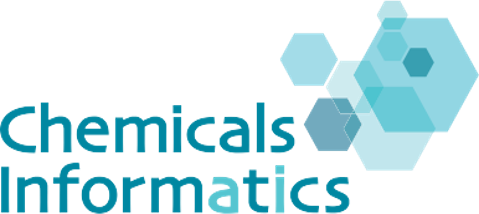
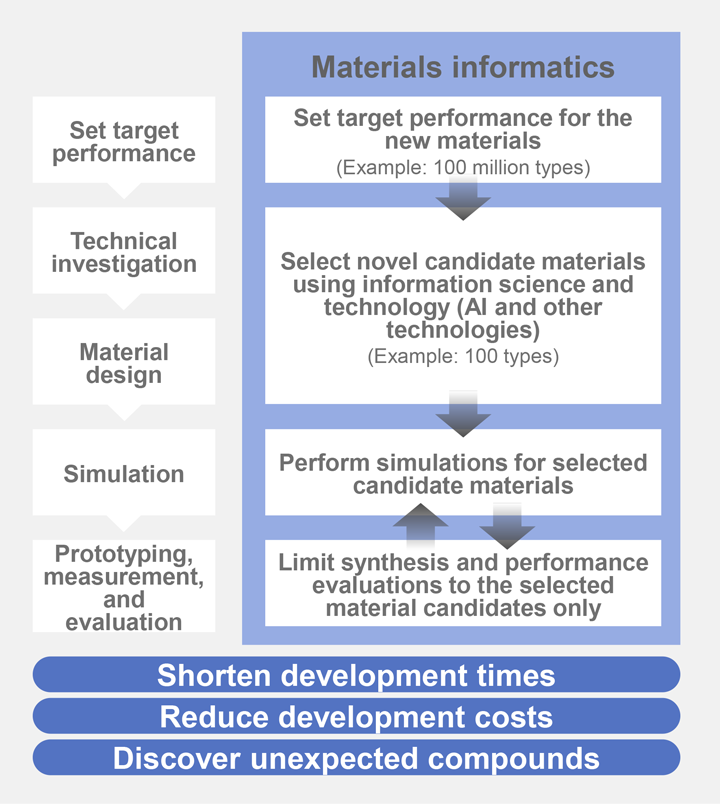
To streamline materials development, MI applies informatics methods that use techniques such as statistical analysis (information science).
In conventional materials development, manual selection of compounds and design rely on the researcher’s knowledge and intuition, and on repeated synthesis to evaluate the properties of compounds. In some cases, a series of coincidences led to the discovery of new materials.
The following benefits can be expected from data-driven R&D combined with informatics:
Improved computer performance and advances in AI technology provide the ability to predict properties derived from synthesizing materials with a high degree of accuracy. Improved experiment success rates reduce the number of experiments that need to be performed. The application of MI in materials engineering continues to grow because of its potential benefits of reducing experiment material waste, protecting resources, and limiting adverse impacts on the environment.
Accelerating the new-product development cycle in the chemical field
Intensifying development competition and technological advances in the chemical industry leads to the expectation that, for a company to remain competitive in this field, the company must be the first to market with a high-value-added product and must capture a high market share.
To incorporate materials informatics (MI) into materials R&D, vast amounts of data used to explore compounds needs to be prepared in a format that can be analyzed by AI.
To achieve this, the Hitachi product Chemicals Informatics (CI) relies on publicly available data, such as patents and research papers. Hitachi’s proprietary NLP AI (natural language processing AI) reads an enormous amount of publicly available data of a highly technical nature, formats it into data suitable for retrieval by the Exploratory AI, and stores it in a compound database. This eliminates the need for the user to prepare data, allowing the user to search and select compounds by applying MI methods immediately after CI is implemented.
The Novel Compound Generation AI, which uses proprietary software programs, generates information on compounds that have novel structures and also stores this information in the compound database. The search results of the Exploratory AI includes compounds that have novel structures, thereby increasing the likelihood of finding promising compounds.
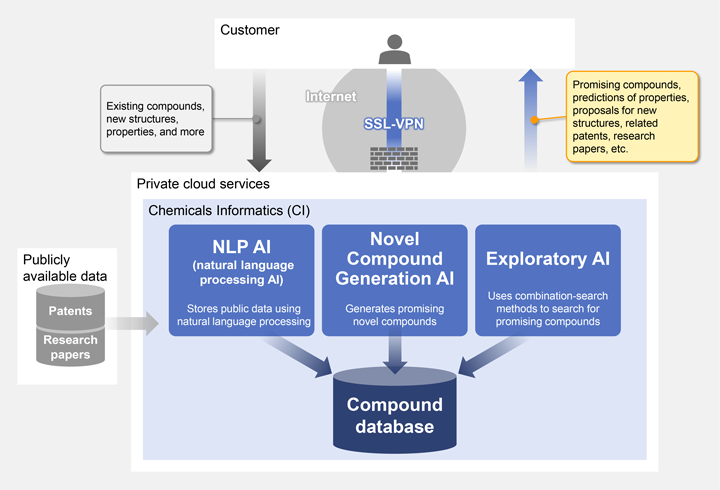
The Hitachi product Chemicals Informatics (CI) aids strategic R&D efforts that aim at finding unpatented compound combinations that have specific, desired properties. This comprehensive approach reduces rework, while also shortening the time to market from the planning stage.
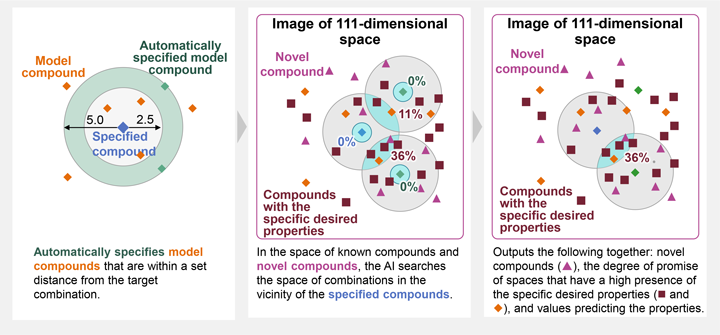
In the past, materials development focused primarily on exploring known compounds within the vicinity of a user-specified compound. As such, discovery of compounds was limited to those that could be found by extending conventional thinking.
Now, however, the Hitachi product Chemicals Informatics (CI) can be used to analyze the structure and elemental composition of over 100 million compounds, and maps them in a 111-dimensional space*1. CI applies proprietary combination-search methods to perform rapid, comprehensive searches of single compounds and composite materials from a vast array of candidates. This ability to explore the unknown opens the door to the discovery of promising compounds in new areas not constrained by conventional thinking. In addition, CI makes it possible to reference values predicting the properties of the found compounds, and also to search the patent and research literature that form the grounds for 61 such properties*2.
The following actual case shows the efficient and comprehensive use of the Hitachi product Chemicals Informatics (CI) to discover new additives that improve biodegradable plastic strength and more readily degrade in natural environments. This case study was jointly conducted by Hitachi, Ltd., Hitachi High-Tech Corporation, and Hitachi High-Tech Solutions Corporation. The results were as follows.
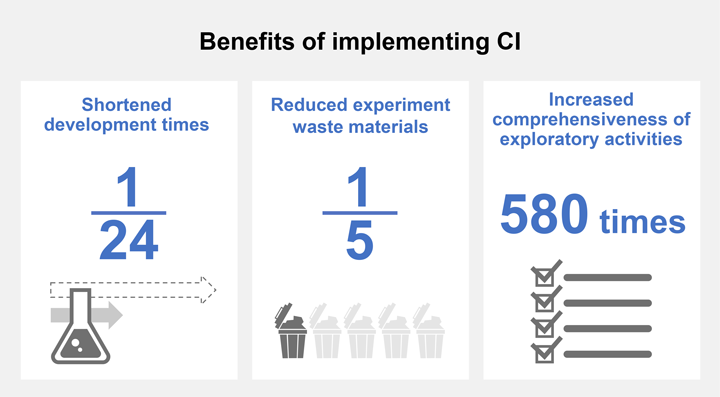
Earth-friendly materials are needed to resolve social problems such as resource depletion and environmental destruction. The Hitachi product Chemicals Informatics (CI) draws upon vast quantities of data stored in a compound database to aid materials development across a broad range of fields, including plastics, electronic components, batteries, and optical materials. CI contributes to the development of materials that strike a balance between environmental considerations and product performance improvements.
The compound database is updated around once every six months to expand the patent information and other publicly available data, so that customers can use the latest available information to search for compounds. As of August 2022, the database encompasses 61 properties and 119 fields, which are continually being added to, including additions made in response to customer requests. Looking ahead, we hope to continue to expand the scope of CI in our aim to incorporate use across a broad range of applications.
For details on our solutions, see the following webpages.
For details on the evaluation of research related to utilizing CI, see the following webpage.
The comprehensive yet rapid selection of compounds based on vast amounts of data helps give our customers an edge over the competition in the development of materials that return to nature, and in capturing market share through the manufacture and sale of products using such materials. These products not only stand to bolster our customer’s reputation for environmental awareness, the recognition of their market value leads to increased sales.